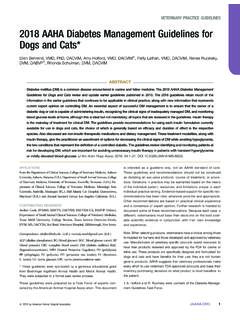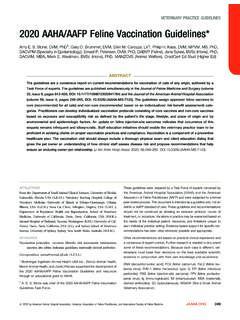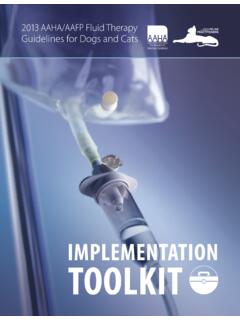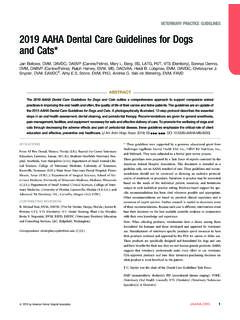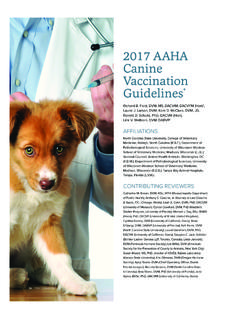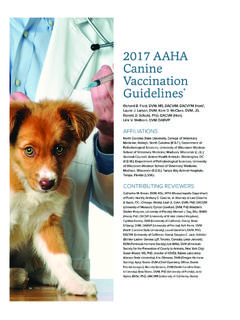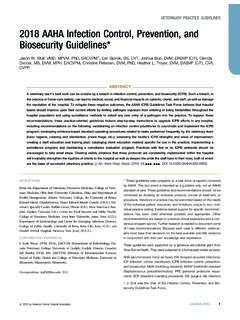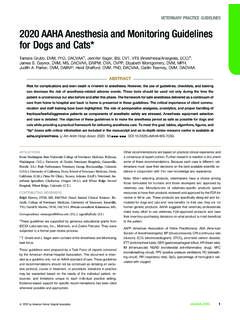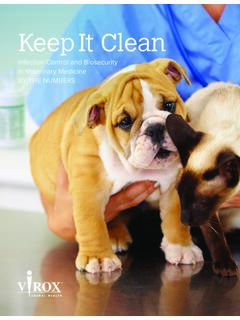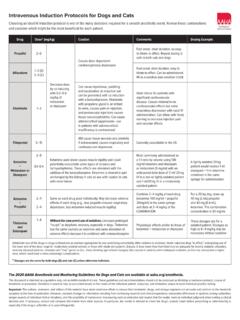Transcription of VETERINARY PRACTICE GUIDELINES 2015 AAHA/AAFP Pain ...
1 VETERINARY PRACTICE GUIDELINES2015 AAHA/AAFP Pain Management Guidelinesfor Dogs and Cats*Mark Epstein, DVM, DABVP, CVPP (co-chairperson), Ilona Rodan, DVM, DABVP (co-chairperson),Gregg Griffenhagen, DVM, MS, Jamie Kadrlik, CVT, Michael Petty, DVM, MAV, CCRT, CVPP, DAAPM,Sheilah Robertson, BVMS, PhD, DACVAA, MRCVS, DECVAA, Wendy Simpson, DVMABSTRACTThe robust advances in pain management for companion animals underlie the decision of AAHA and AAFP to expand onthe information provided in the2007 AAHA/AAFP Pain Management GUIDELINES for Dogs and Cats. The 2015 guidelinessummarize and offer a discriminating review of much of this new knowledge. Pain management is central to veterinarypractice, alleviating pain, improving patient outcomes, and enhancing both quality of life and the veterinarian-client-patient relationship. The management of pain requires a continuum of care that includes anticipation, early intervention,and evaluation of response on an individual-patient basis.
2 The GUIDELINES include both pharmacologic andnonpharmacologic modalities to manage pain; they are evidence-based insofar as possible and otherwise representa consensus of expert opinion. Behavioral changes are currently the principal indicator of pain and its course ofimprovement or progression, and the basis for recently validated pain scores. A team-oriented approach, including theowner, is essential for maximizing the recognition, prevention, and treatment of pain in animals. Postsurgical pain iseminently predictable but a strong body of evidence exists supporting strategies to mitigate adaptive as well asmaladaptive forms. Degenerative joint disease is one of the most significant and under-diagnosed diseases of cats anddogs. Degenerative joint disease is ubiquitous, found in pets of all ages, and inevitably progresses over time; evidence-based strategies for management are established in dogs, and emerging in cats.
3 These GUIDELINES support veterinariansin incorporating pain management into PRACTICE , improving patient care.(J Am Anim Hosp Assoc2015; 51:67 84. )From the Total Bond VETERINARY Hospitals PC, Gastonia, NC ( ); CatCare Clinic and Feline-Friendly Consultations, Madison, WI ( ); VETERINARY Teaching Hospital, Colorado State University School ofVeterinary Medicine, Fort Collins, CO ( ); Pet Crossing AnimalHospital & Dental Clinic, Bloomington, MN ( ); Arbor PointeVeterinary Hospital/Animal Pain Center, Canton, ( );Department of Small Animal Clinical Sciences, Michigan StateUniversity, East Lansing, MI ( ); and Morrisville Cat Hospital,Morrisville, NC ( ).Correspondence: ( )AAHA, American Animal Hospital Association; AAFP, AmericanAssociation of Feline Practitioners; AE, adverse event; CKD, chronickidney disease; CMI, clinical measurement instrument; CRI, constantrate infusion; COX, cyclooxygenase; DJD, degenerative joint disease;GI, gastrointestinal; LA, local anesthetic; MPS, myofascial painsyndrome; NSAID, nonsteroidal anti-inflammatory drug; OA, osteo-arthritis; PSGAG, polysulfated glycosaminoglycan; SS(N)RI, selectiveserotonin (norepinephrine) reuptake inhibitor; TCA, tricyclic antide-pressant.
4 QOL, quality of life*These GUIDELINES were prepared by a task force of experts convened bythe American Animal Hospital Association and the American Associationof Feline Practitioners for the express purpose of producing this GUIDELINES are supported by a generous educational grant fromAbbott Animal Health, Elanco Companion Animal Health, Merial, NovartisAnimal Health, and Zoetis, and are endorsed by the InternationalVeterinary Academy of Pain Management. They were subjected to thesame external review process as by American Animal Hospital management is central to VETERINARY PRACTICE , not pain is not only a professional obligation (recall theveterinarians pledge to the relief of animal pain and suffering )but also a key contributor to successful case outcomes andenhancement of the veterinarian-client-patient relationship. Acommitment to pain management identifies a PRACTICE as one thatis committed to compassionate care; optimum recovery fromillness, injury, or surgery; and enhanced quality of GUIDELINES continue the trend in all branches ofmedicine toward evidence-based consensus statements that addresskey issues in clinical PRACTICE .
5 Although not a review article, thiscompilation is a force multiplier for the busy practitioner,consolidating in a single place current recommendations andinsights from experts in pain management. These GUIDELINES are theproduct of a collaborative effort by the American Animal HospitalAssociation (AAHA) and the American Association of FelinePractitioners (AAFP). The recommendations of the GUIDELINES TaskForce are evidence based insofar as possible and otherwiserepresent a consensus of expert GUIDELINES are designed to expand on the informationcontained in the2007 AAHA/AAFP Pain Management GUIDELINES forDogs and ,2 The 2015 GUIDELINES differ from the earlier versionin several ways. The first sections are general concepts designed to set the stage for the remaining, more specific content. The 2015guidelines also discuss the importance of an integrated approach tomanaging pain that does not rely strictly on analgesic drugs.
6 Becausepain assessment in animals has become more scientifically groundedin recent years, various clinically validated instruments for scoringpain in both dogs and cats are described. The extensive list ofpublished references includes numerous studies published within thepast 3 yr, reflecting the rapid pace of advances in managing pain forcompanion animals. The 2015 GUIDELINES summarize and offer adiscriminating review of much of this new of PainAll types of tissue injury can be generators of pain. Occasionally,pain may occur in the absence of such causative the mechanisms of pain is the key to its successfulprevention and treatment. The pain response is unique to eachindividual and involves twocomponents: (1) the sensorycomponent is nociception, which is the neural processing ofnoxious stimuli and (2) the affective component is pain perception,which is the unpleasant sensory and emotional experienceassociated with either actual or potential tissue damage.
7 Pain isthe endpoint of nociceptive input and can only occur in aconscious animal; however, there is also involvement of autonomicpathways and deeper centers of the brain involved with emotionand memory. Hence pain is a multi-dimensional experience; it isnot justwhatyou feel but alsohowit makes you pain has been defined as pain that exists during theexpected time of inflammation and healing after injury (up to 3mo), and chronic pain is defined as that which exists beyond theexpected duration associated with acute pain. Therapy should befocused on the underlying cause of pain, (nociceptive, inflamma-tory, or pathological) rather than on arbitrary labels based pain occurs when peripheral neural receptors areactivated by noxious stimuli ( , surgical incisions, trauma, heat,or cold). Inflammatory pain results gradually from activation of theimmune system in response to injury or infection, and pathologicalpain, also called maladaptive pain, occurs when pain is amplifiedand sustained by molecular, cellular, and microanatomic changes,collectively termed peripheral and central pain is characterized by hyperalgesia (exaggeratedresponse to noxious stimulus), allodynia (painful response tononnoxious stimuli, such as touch or pressure), expansion of thepainful field beyond its original boundaries, and pain protractedbeyond the expected time of inflammation and healing.
8 Undersome conditions, genomic, phenotypic changes occur that createthe condition known as neuropathic pain, whereby pain can beconsidered a disease of the central nervous system. Those changesare not necessarily chronologic. Maladaptive pain, or the risk for it,can occur within a matter of minutes of certain acute painconditions ( , nerve injury, severe tissue trauma, or presence ofpre-existing inflammation).A Continuum of CareAppropriate pain management requires a continuum of care basedon a well-thought-out plan that includes anticipation, earlyintervention, and evaluation of response on an individual-patientbasis. It should be noted that response to therapy is a legitimatepain assessment tool. Continuous management is required forchronically painful conditions, and for acute conditions until painis resolved. The acronym PLATTER has been devised to describethe continuum of care loop for managing pain (Figure 1).
9 Thecomponents of the PLATTER algorithm for pain management arePLan,Anticipate,TreaT,Evaluate, s Not Just About DrugsClassic VETERINARY medical education places a strong emphasis ontreatment of disease through pharmacology and surgery, the68 JAAHA|51:2 Mar/Apr 2015esoteric skills that are the domain of the trained , evidence-based data and empirical experience justifya strong role for nonpharmacologic modalities for pain manage-ment. A number of those should be considered mainstreamoptions and an integral part of a balanced, individualizedtreatment of nonpharmacologic treatments supported bystrong evidence include, but are not limited to, cold compression,weight optimization, and therapeutic exercise. Other treatmentoptions gaining increasing acceptance include acupuncture,physical rehabilitation, myofascial trigger point therapy, therapeu-tic laser, and other modalities, which are discussed in theseguidelines.
10 In addition, nonpharmacologic adjunctive treatmentincludes an appreciation of improved nursing care, gentle handling,caregiver involvement, improved home environment, and hospicecare. Those methods have the critical advantages of increasedcaregiver-clinician interaction and a strengthening of the human-pet bond. That shared responsibility promotes a team approachand leads to a more complete and rational basis for painmanagement and Assessment of PainThe Patient s Behavior is the KeyBecause animals are nonverbal and cannot self-report the presenceof pain, the burden of pain assumption, recognition, andassessment lies with VETERINARY professionals. It is now acceptedthat the most accurate method for evaluating pain in animals is notby physiological parameters but by observations of behavior. Painassessment, should be a routine component of every physicalexamination, and a pain score is considered the fourth vital sign, after temperature, pulse, and ,2,6 Obtaining a thoroughpatient history from the owner can help determine abnormalbehavior patterns that may be pain related.
